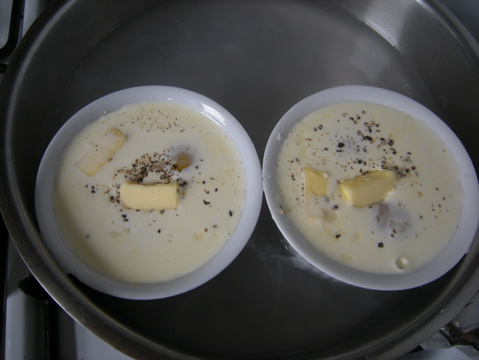
Sunday morning I made Oeufs Cocotte à la Crème. This is another dish that was often served at my family hotel-restaurant and below is the scan of a menu from my grand father Joseph Peyrafitte’s menu notebook.
 On Thursday May 2nd 1968 Oeufs Cocotte were served as the first course of the traditional five courses lunch menu. As you can see this lunch did not lack proteins!
On Thursday May 2nd 1968 Oeufs Cocotte were served as the first course of the traditional five courses lunch menu. As you can see this lunch did not lack proteins!
Appetizer: Jambon de Pays (Prosciutto type ham from the Pyrenees)
First Couse: Oeufs Cocotte à la Crème (see recipe below)
Main Course: Pistache Luchonnaise ( a white bean & lamb stew with pork rind — a specialty of the Comminges region. I will have to do a post on this dish)
Plateau de Fromage : not mentioned here but a given.
Dessert Course: Strawberries & Fresh Quark Cheese.
I served the Oeufs Cocotte for brunch and they were incredibly delicious.
Recipe:
But first, what is a cocotte: it is a small fireproof dish in which individual portions of food are cooked and served.

Escoffier recipe from a second edition of the book published in 1907
-Break 2 eggs per person in a bowl and reserve them for later. Escoffier skips this step but I like to do it for two reasons: 1) the eggs will reach room temperature and 2) it will be easier to remove any egg shell bits and check on the quality of the eggs before pouring them into the final dish.
-Warm up the cocotte dishes in a pan filled with water half way
-In a small pan warm up one (generous) table spoon of the heavy cream per person.
-Pour one of these table spoons of hot heavy cream into each of the warm cocotte dishes. Then add the eggs. Season to taste (Escoffier does not give quantities for seasoning. I used salt & pepper, next time I will add a little paprika), two little pieces of butter (you can see below how much I did put in).
-Cook covered in double boiler for about 4/6 minutes depending on how you like your eggs; the water shouldn’t go higher that 1/2 way up the cocotte dishes. Escoffier doesn’t tell how long it should be cooked; I did mine for about 5 minutes, they were perfect, but that is a matter of taste — I like my eggs very soft.
-Dig in with a spoon and have rye bread toast on the side. Do not butter the toasts! that would be excessive, it is decadent enough as it is! Bon Appetit!







